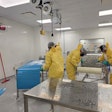For the first time in history, Purina scientists demonstrate a proactive way to significantly reduce the active levels of the major cat allergen, Fel d1, at its source in cats' saliva. As many as one in five adults worldwide are sensitized to cat allergens.1 Avoiding cats is a cornerstone of managing allergens, an approach that may leave cats looking for a new home. Taking advantage of natural allergen-antibody interactions, Purina researchers discovered how to safely neutralize Fel d1 in hair and dander by incorporating an egg product containing anti-Fel d1 antibodies into a cat's diet. Ultimately this will reduce active Fel d1 levels in the environment. This approach maintains normal allergen production by the cat, without affecting the cat's overall physiology. This innovative method, presented by Purina scientists at the European Academy of Allergy and Clinical Immunology Congress 2019, can transform the way people manage cat allergens; it reduces exposure to the allergen, but not to the cat.
"These allergens have created a huge barrier to cat ownership and may limit the loving interactions between cat lovers and cats," says immunologist Dr. Ebenezer Satyaraj, Director of Molecular Nutrition at Purina and lead investigator on the research. "Our discovery has the potential to transform how people manage cat allergens."
Contrary to a popular perception, there are no truly hypoallergenic cats. All cats produce Fel d1 – regardless of breed, age, hair length, hair color, sex, or body weight. Up to 95 percent of reactions in cat allergen-sensitive people are caused by Fel d1.2 Produced primarily in cats' salivary and sebaceous glands, Fel d1 is transferred to a cat's hair and skin during grooming, then dispersed in the environment via hair and dander (dried flakes of skin).3, 4
A response in people sensitized to Fel d1 occurs when the allergen comes into contact with the individual and then binds with specialized immune defense proteins in their body. In this groundbreaking research, spanning more than a decade, Purina scientists found that an anti-Fel d1 antibody (IgY) can block specific sites on Fel d1 produced in cats' saliva, thereby neutralizing the allergen.
According to a landmark Purina study, published in Immunity, Inflammation and Disease, when cats were fed a diet including this egg product with IgY, 97% showed decreased levels of active Fel d1 on the hair and dander. On average, there was a 47% reduction of active Fel d1 on cats' hair after three weeks of feeding the diet. Decreasing active Fel d1 on a cat's hair can reduce cat allergens shed into the environment on hair and dander. Reducing the allergen load in the environment has been shown to be beneficial to allergen-sensitive people.5 This was validated in a recent environmentally-controlled study conducted by researchers at Washington University, St. Louis, Missouri.6
These breakthrough findings reveal a revolutionary approach to managing cat allergens. As more results become available, the Purina Institute, an organization which serves as the global voice of Purina's scientific communications, will share that information.
"At Purina, we imagine a world where nutritional innovation can be life changing," says Dan Smith, Vice President, Research and Development, Purina. "We believe pets and people are better together. This breakthrough finding has the potential to improve the lives of cats and the people who love them."
For more information about this research, and the Purina Institute, please visit: www.purinainstitute.com.
1 Zahradnik, E., & Raulf, M. (2017). Respiratory Allergens from Furred Mammals: Environmental and Occupational Exposure. Veterinary Sciences 4, 38.
2 Bonnet, B., Messaoudi, K., Jacomet, F., Michaud, E., Fauquert, J. L., Caillaud, D., & Evrard, B. (2018). An update on molecular cat allergens: Fel d 1 and what else? Chapter 1: Fel d1, the major cat allergen. Allergy, Asthma and Clinical Immunology, 14, pp. 14-23. doi: 10.1186/s13223-018-0239-8.
3 Bartholome, K., Kissler, W., Baer, H., Kopietz Schulte, E., & Wahn, U. (1985). Where does cat allergen 1 come from? Journal of Allergy and Clinical Immunology,76, 503–506.
4 Dabrowski, A., Van der Brempt, X., Soler, M., Seguret, N., Lucciani, P., Charpin, D., & Vervloet, D. (1990). Cat skin as an important source of Fel d1 allergen. Journal of Allergy and Clinical Immunology, 86, 462–465.
5 Wickman, M. (2005). When allergies complicate allergies. Allergy, 60 (Supplement 79), 14-18.
6 Wedner, J., Satyaraj, E., Gardner, C., Al-Hammadi, N., Sherrill, S., & Mantia, T. (2019, June). Pilot study to determine effect of feeding cat food made with egg product containing anti-Fel d1 antibodies to cats on human allergy symptoms. Presented at the European Academy of Allergy and Clinical Immunology Congress, Lisbon, Portugal.












